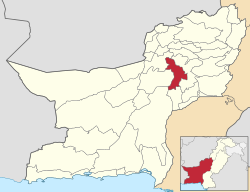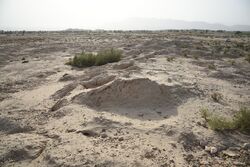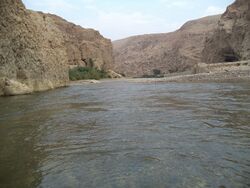ضلع كتشهي
Kachhi District
ضلع کچّھی | |
|---|---|
Top: Ruins of Mehrgarh Bottom: Seasonal river in Kachhi district | |
 Map of Balochistan with Kacchi District highlighted | |
| البلد | |
| الإقليم | |
| القِسم | نصير آباد |
| Established | December 1991 |
| المقر الرئيسي | دهادر |
| الحكومة | |
| • النوع | District Administration |
| • Deputy Commissioner | N/A |
| • District Police Officer | N/A |
| • District Health Officer | N/A |
| المساحة | |
| • الإجمالي | 5٬682 كم² (2٬194 ميل²) |
| التعداد (2017)[1] | |
| • الإجمالي | 309٬932 |
| • الكثافة | 55/km2 (140/sq mi) |
| منطقة التوقيت | UTC+5 (PST) |
| الموقع الإلكتروني | Official website |
ضلع كچهي/كتشهي ( Kachhi District أو Kacchi ؛ بلوچي: کچّی دمگ، أردو: ضلع کچّھی), known until 2008 as Bolan District[2] (بلوچي: بولان, is a district located in the central part of the Balochistan province in Pakistan.[3] The Bolan area remained under one district Kacchi until 31 December 1991. The Deputy Commissioner's office started functioning on 17 May 1992, and Bolan became one of the four districts of Naseerabad Division, until the abolition of Divisions in 2000.
In 2013, it was announced that the tehsil of Bhag would be split off to form part of the new Lehri District.[4]
التاريخ
The Kachhi Plains are the home of the archeological site of Mehrgarh. One of the most important Neolithic sites in archaeology, lies on what is now the Kachhi Plain of today's Balochistan, Pakistan. It is one of the earliest sites with evidence of farming (wheat and barley) and herding (cattle, sheep and goats) in South Asia.[5]
Until the end of the 15th century mehargarh was ruled by meena tribe.[6] Around 1500, it was taken by Shah Beg of the Arghun dynasty from the Samma dynasty of the Sultans of Sindh. The territory was conquered by the Kalhora Amirs of Sindh,[7][8] who were themselves displaced by the Nadir Shah of Persia. Shah gave the territory to the Kalat Khanate in 1740.[9][10] Kachhi was notified as a district in February 1965. At that time Naseerabad, Jhal Magsi and Jafarabad districts were included; these were separated in 1987.
التقسيمات الإدارية
The district is administratively subdivided into the following Tehsils:[3]
The Union councils of Kachhi District are:
السكان
At the time of the 2017 census the district had 40,896 households and a population of 309,932, of which 164,291 were males and 145,633 females. Rural population was 258,952 (83.55%) while the urban population was . Kachhi had a sex ratio of 886 females per 1000 males and a literacy rate of 32.98% - 42.44% for males and 22.31% for females. 50,980 (16.45%) lived in urban areas. 109,556 (35.34%) were under 10 years of age. Islam was the predominant religion with 98.83%, while Hindus were 1.04% of the population.[1]
At the time of the 2017 census, 44.53% of the population spoke Balochi, 22.78% Sindhi, 18.43% Saraiki and 12.51% Brahui as their first language.[1]
| الدين | Population (1941)[11] | Percentage (1941) | Population (2011)[بحاجة لمصدر] | Percentage (2011) |
|---|---|---|---|---|
| Islam |
79,016 | 91.76% | 306,306 | 98.83% |
| Hinduism |
7,095 | 8.24% | 3,223 | 1.04% |
| Sikhism |
1 | 0% | N/A | N/A |
| Christianity |
N/A | N/A | 403 | 0.13% |
| Total Population | 86,112 | 100% | 309,932 | 100% |
التعليم
According to the Pakistan District Education Rankings 2017, district Kachhi is ranked at number 109 out of the 141 ranked districts in Pakistan on the education score index. This index considers learning, gender parity and retention in the district.
Literacy rate in 2014–15 of population 10 years and older in the district stood at 43% whereas for females it was only 23%.[12]
Post primary access is a major issue in the district with 86% schools being at primary level. Compare this with high schools which constitute only 6% of government schools in the district. This is also reflected in the enrolment figures for 2016–17 with 12,688 students enrolled in class 1 to 5 and only 261 students enrolled in class 9 and 10.
Gender disparity is another issue in the district. Only 28% schools in the district are girls’ schools. Access to education for girls is a major issue in the district and is also reflected in the low literacy rates for females.
Moreover, the schools in the district lack basic facilities. According to Alif Ailaan Pakistan District Education Rankings 2017, the district is ranked at number 139 out of the 155 districts of Pakistan for primary school infrastructure. At the middle school level, it is ranked at number 129 out of the 155 districts. These rankings take into account the basic facilities available in schools including drinking water, working toilet, availability of electricity, existence of a boundary wall and general building condition. More than half of the government schools in the district do not have electricity, toilet and a boundary wall. 213 out of 465 schools do not have clean drinking water.
The main issues for the district is the unavailability of teachers in schools.[13]
ملاحظات
- ^ Historic district borders may not be an exact match in the present-day due to various bifurcations to district borders — which since created new districts — throughout the historic Baluchistan Agency region during the post-independence era that have taken into account population increases. This discrepancy can be seen in the district population history table which has taken into account the various bifurcations since 1941.
- ^ 1941 census: Including Ad-Dharmis
المراجع
- ^ أ ب ت ث "District Wise Results / Tables (Census - 2017)". www.pbscensus.gov.pk. Pakistan Bureau of Statistics.
- ^ District Bolan renamed Kachhi
- ^ أ ب Tehsils & Unions in the District of Bolan - Government of Pakistan
- ^ New district in Balochistan, dawn.com
- ^ Hirst, K. Kris. 2005. Mehrgarh, Pakistan - Life in the Indus Valley Before Harappa. Thought Co.
- ^ "Sibi". Visitorsheaven.com. Retrieved 2017-07-17.
- ^ "Cities of Pakistan (Sibi)". PakistanPaedia. 2009-02-02. Retrieved 2017-07-17.
- ^ "Being private in public". DAWN Magazine. 6 May 2007. Archived from the original on 2007-08-03. Retrieved 2011-03-17.
- ^ Sibi District - Imperial Gazetteer of India, v. 22, p. 338.
- ^ "Ghulam Shah Kalhora and Relations With Kutch". Panhwar.com. 2002-11-02. Retrieved 2017-07-17.
- ^ "CENSUS OF INDIA, 1941 VOLUME 14 BALUCHISTAN". Retrieved 20 July 2022.
- ^ Pakistan Bureau of Statistics (2016). "Pakistan Social and Living Standards Measurement Survey 2014-15" (PDF). Islamabad: Government of Pakistan. p. 111. Retrieved 6 August 2018.
- ^ "Taleem Do! App – Elections 2018 | #TaleemDo". elections.alifailaan.pk. Archived from the original on 3 August 2018. Retrieved 12 January 2022.
وصلات خارجية
ببليوجرافيا
- 1998 District census report of Kachhi (Bolan). Census publication. Vol. 105. Islamabad: Population Census Organization, Statistics Division, Government of Pakistan. 2000.
خطأ لوا في وحدة:Authority_control على السطر 278: attempt to call field '_showMessage' (a nil value).
- Pages using gadget WikiMiniAtlas
- Short description is different from Wikidata
- Pages using infobox settlement with no coordinates
- Articles containing Balochi-language text
- Articles containing أردو-language text
- Pages using Lang-xx templates
- مقالات ذات عبارات بحاجة لمصادر
- Coordinates on Wikidata
- ضلع كچهي
- Districts of Balochistan, Pakistan


